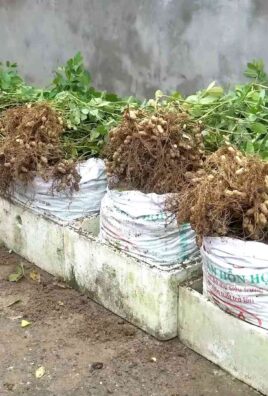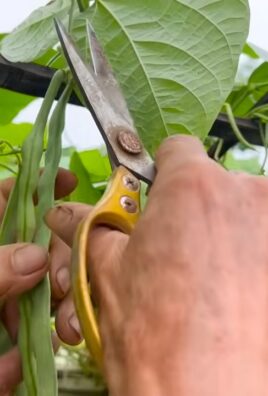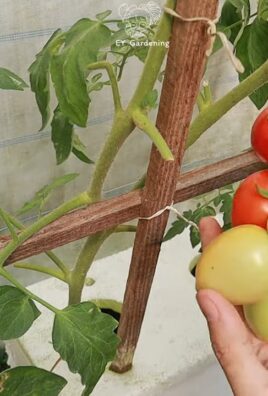Grow Yellow Habanero Peppers, and transform your garden into a vibrant, spicy paradise! Have you ever dreamed of harvesting your own fiery peppers, adding a burst of sunshine and intense flavor to your favorite dishes? Well, dream no more! This DIY guide is your passport to cultivating these beautiful and potent peppers right in your backyard.
The Habanero, with its distinctive lantern shape and scorching heat, has a rich history rooted in the Yucatan Peninsula of Mexico. For centuries, it’s been a staple in Mayan cuisine, adding a fiery kick to everything from salsas to stews. Now, you can bring a piece of that culinary heritage to your own table.
Why should you embark on this pepper-growing adventure? Because store-bought peppers simply can’t compare to the satisfaction of nurturing your own plants from seed to harvest. Plus, knowing exactly where your food comes from and how it’s grown is incredibly empowering. With the right techniques, even beginner gardeners can successfully grow Yellow Habanero Peppers. I’m here to share all my secrets and tips, ensuring you have a bountiful harvest of these sunshine-colored gems. Get ready to spice up your life, one pepper at a time!

Growing Yellow Habanero Peppers: A Fiery DIY Guide
Alright, spice lovers! Are you ready to embark on a journey to cultivate your own sunshine-yellow fireballs? Growing habanero peppers can seem intimidating, but trust me, with a little patience and the right know-how, you can have a thriving pepper patch bursting with these flavorful beauties. I’m going to walk you through everything you need to know, from seed to salsa!
Getting Started: Seeds and Seedlings
The first step is, of course, getting your hands on some habanero pepper seeds. You can find these online, at your local garden center, or even save seeds from a pepper you bought (though the results can be a little unpredictable with saved seeds).
* Choosing Your Seeds: Look for reputable seed companies that specialize in peppers. Read reviews and choose varieties known for good germination rates and disease resistance. Yellow habaneros are the classic, but you might also find variations like ‘Golden Habanero’ or ‘Mustard Habanero’ for a slightly different flavor profile.
* Starting Indoors (Recommended): Habaneros have a long growing season, so starting them indoors 6-8 weeks before the last expected frost is crucial. This gives them a head start.
* Materials You’ll Need:
* Habanero pepper seeds
* Seed starting trays or small pots
* Seed starting mix (a light, well-draining mix is best)
* Spray bottle
* Heat mat (optional, but highly recommended)
* Grow light (also optional, but helps prevent leggy seedlings)
Step-by-Step Seed Starting:
1. Prepare Your Seed Starting Trays: Fill your seed starting trays or pots with the seed starting mix. Gently tap the trays to settle the mix.
2. Sow the Seeds: Make a small indentation (about ¼ inch deep) in the center of each cell or pot. Place 2-3 seeds in each indentation. This increases your chances of at least one seed germinating.
3. Cover the Seeds: Gently cover the seeds with the seed starting mix.
4. Water Carefully: Use a spray bottle to mist the soil thoroughly. You want the soil to be moist but not soggy.
5. Provide Warmth: Place the trays on a heat mat. Habanero seeds germinate best in warm temperatures (around 80-85°F).
6. Maintain Moisture: Cover the trays with a humidity dome or plastic wrap to help retain moisture.
7. Provide Light: Once the seeds germinate (usually within 7-21 days), remove the humidity dome and place the trays under a grow light or in a sunny window. If using a window, rotate the trays regularly to prevent the seedlings from leaning towards the light.
8. Water Regularly: Keep the soil consistently moist, but avoid overwatering. Let the top inch of soil dry out slightly between waterings.
9. Thin the Seedlings: Once the seedlings have their first true leaves (the second set of leaves that appear after the initial seed leaves), thin them out by snipping off the weaker seedlings at the soil line. Leave only the strongest seedling in each cell or pot.
Transplanting Your Seedlings
Once the danger of frost has passed and the soil has warmed up, it’s time to transplant your habanero seedlings outdoors.
* Hardening Off: Before transplanting, you need to “harden off” your seedlings. This process gradually acclimates them to the outdoor environment. Start by placing the seedlings outdoors in a sheltered location for an hour or two each day, gradually increasing the amount of time they spend outside over the course of a week or two.
* Choosing a Location: Habaneros need plenty of sunshine (at least 6-8 hours per day) and well-draining soil. Choose a location that meets these requirements.
* Soil Preparation: Amend the soil with compost or other organic matter to improve drainage and fertility. Habaneros prefer slightly acidic soil (pH 6.0-6.8).
* Spacing: Space the seedlings about 18-24 inches apart.
Step-by-Step Transplanting:
1. Dig the Holes: Dig holes that are slightly larger than the root balls of your seedlings.
2. Remove the Seedlings: Gently remove the seedlings from their trays or pots. Be careful not to damage the roots.
3. Plant the Seedlings: Place the seedlings in the holes and backfill with soil. Gently firm the soil around the base of the plants.
4. Water Thoroughly: Water the seedlings thoroughly after transplanting.
5. Mulch: Apply a layer of mulch around the plants to help retain moisture, suppress weeds, and regulate soil temperature.
Caring for Your Habanero Plants
Now that your habanero plants are in the ground, it’s time to provide them with the care they need to thrive.
* Watering: Water regularly, especially during hot, dry weather. Habaneros need consistent moisture, but avoid overwatering, which can lead to root rot. A good rule of thumb is to water when the top inch of soil feels dry.
* Fertilizing: Fertilize your habanero plants every 2-3 weeks with a balanced fertilizer. You can also use a fertilizer specifically formulated for peppers. Avoid fertilizers that are too high in nitrogen, as this can promote leafy growth at the expense of fruit production.
* Pruning: Pruning is not essential for habaneros, but it can help improve air circulation and sunlight penetration, which can lead to better fruit production. You can prune away any suckers (small shoots that grow from the base of the plant) or any crowded or crossing branches.
* Pest and Disease Control: Keep an eye out for pests and diseases. Common pests that affect habaneros include aphids, spider mites, and whiteflies. Common diseases include blossom end rot and fungal infections. Treat any problems promptly with appropriate organic pesticides or fungicides.
* Support: As your habanero plants grow, they may need support to prevent them from falling over. You can use stakes, cages, or trellises to provide support.
Harvesting Your Habanero Peppers
The moment you’ve been waiting for! Harvesting your fiery yellow treasures.
* When to Harvest: Habanero peppers are typically ready to harvest about 80-100 days after transplanting. They will turn from green to yellow (or orange, depending on the variety) when they are ripe.
* How to Harvest: Use pruning shears or scissors to cut the peppers from the plant. Be careful not to damage the plant.
* Handling with Care: Wear gloves when handling habanero peppers, as the capsaicin (the compound that makes them hot) can irritate your skin. Avoid touching your eyes or face after handling the peppers.
Step-by-Step Harvesting:
1. Identify Ripe Peppers: Look for peppers that are fully yellow (or orange) and have a slightly wrinkled appearance.
2. Wear Gloves: Protect your hands by wearing gloves.
3. Cut the Peppers: Use pruning shears or scissors to cut the peppers from the plant, leaving a small stem attached.
4. Handle Carefully: Place the harvested peppers in a basket or container.
5. Wash Your Hands: After harvesting, wash your hands thoroughly with soap and water.
Using Your Habanero Peppers
Now that you have a bounty of habanero peppers, it’s time to put them to good use!
* Fresh: Use them fresh in salsas, sauces, and other dishes. Remember that a little goes a long way!
* Dried: Dry them for later use. You can dry them in a dehydrator, in the oven, or by stringing them up and hanging them in a well-ventilated area.
* Pickled: Pickle them for a tangy and spicy treat.
* Frozen: Freeze them for long-term storage.
A Word of Caution: Habanero peppers are extremely hot! Use them sparingly and always taste before adding more. If you accidentally eat too much, drink milk or eat something fatty to help neutralize the capsaicin.
Troubleshooting
Even with the best care, you might encounter some problems along the way. Here are a few common issues and how to address them:
* Blossom End Rot: This is a common problem in peppers, caused by a calcium deficiency. The bottom of the pepper will turn black and rot. To prevent blossom end rot, make sure your soil is well-drained and that you are providing your plants with adequate calcium. You can add calcium to the soil by amending it with bone meal or by using a calcium-rich fertilizer.
* Aphids: These small, sap-sucking insects can weaken your plants. You can control aphids by spraying them with

Conclusion
So, there you have it! Growing your own yellow habanero peppers isn’t just a gardening project; it’s an adventure in flavor, a testament to your green thumb, and a guaranteed way to spice up your culinary creations. We’ve walked through the essential steps, from selecting the perfect seeds to nurturing your plants and finally harvesting those vibrant, fiery fruits.
Why is this DIY trick a must-try? Because store-bought habaneros, while convenient, often lack the intense flavor and satisfying heat of homegrown peppers. Plus, you have complete control over the growing process, ensuring your peppers are organic, pesticide-free, and bursting with sunshine. Imagine the satisfaction of adding a dash of your own homegrown heat to your favorite salsa, chili, or even a daring dessert!
But the fun doesn’t stop there. Feel free to experiment with different growing techniques. Try hydroponics for a faster harvest, or explore different soil amendments to enhance the flavor profile of your peppers. Consider companion planting with basil or carrots to deter pests and improve growth. You can even try saving seeds from your most successful plants to create your own unique strain of yellow habanero peppers over time.
And speaking of variations, don’t limit yourself to just yellow habaneros! Once you’ve mastered the art of growing these fiery gems, branch out and explore other varieties like red habaneros, scotch bonnets, or even milder peppers like jalapenos. The possibilities are endless!
Ultimately, growing your own yellow habanero peppers is a rewarding experience that connects you to the food you eat and empowers you to create truly unique and flavorful dishes. It’s a project that’s both challenging and incredibly satisfying, and the results are well worth the effort.
We wholeheartedly encourage you to give this DIY trick a try. Start small, be patient, and don’t be afraid to experiment. And most importantly, share your experience with us! We’d love to hear about your successes, your challenges, and any tips or tricks you discover along the way. Post pictures of your plants, share your favorite recipes, and let’s build a community of passionate pepper growers together. So, grab your seeds, get your hands dirty, and get ready to experience the fiery delight of homegrown yellow habanero peppers! You won’t regret it.
Frequently Asked Questions (FAQ)
What is the ideal climate for growing yellow habanero peppers?
Yellow habanero peppers thrive in warm climates with plenty of sunshine. They require a long growing season, typically 100-120 days from transplanting to harvest. Ideally, temperatures should be between 70-85°F (21-29°C) during the day and no lower than 60°F (15°C) at night. If you live in a cooler climate, you can start your seeds indoors 6-8 weeks before the last expected frost and transplant them outdoors once the weather warms up. Greenhouses or cold frames can also extend the growing season.
How often should I water my yellow habanero pepper plants?
Watering frequency depends on several factors, including the weather, soil type, and size of the plant. Generally, you should water your pepper plants deeply whenever the top inch of soil feels dry to the touch. Avoid overwatering, as this can lead to root rot. During hot, dry weather, you may need to water daily. In cooler, wetter weather, you may only need to water every few days. Using a moisture meter can help you determine the moisture level of the soil and avoid over or under-watering.
What kind of soil is best for growing yellow habanero peppers?
Yellow habanero peppers prefer well-draining soil that is rich in organic matter. A slightly acidic to neutral pH (6.0-7.0) is ideal. You can improve the soil by adding compost, aged manure, or other organic amendments. Avoid heavy clay soils, as they can retain too much water and lead to root rot. If you have clay soil, amend it with plenty of organic matter and consider growing your peppers in raised beds or containers.
What are the most common pests and diseases that affect yellow habanero pepper plants?
Common pests that can affect yellow habanero pepper plants include aphids, spider mites, whiteflies, and pepper weevils. Diseases include fungal infections like powdery mildew, blossom end rot, and bacterial leaf spot. Regularly inspect your plants for signs of pests or diseases. You can control pests with insecticidal soap, neem oil, or by introducing beneficial insects like ladybugs. Prevent diseases by providing good air circulation, avoiding overwatering, and using disease-resistant varieties.
How do I know when my yellow habanero peppers are ripe?
Yellow habanero peppers are typically ready to harvest when they turn a vibrant yellow color and are firm to the touch. The exact shade of yellow may vary depending on the specific variety. The peppers should also be relatively easy to detach from the plant. If you’re unsure, you can taste a small piece of the pepper to check for heat and flavor. Remember to wear gloves when handling habanero peppers, as the capsaicin oil can irritate your skin.
Can I grow yellow habanero peppers in containers?
Yes, yellow habanero peppers can be successfully grown in containers. Choose a container that is at least 5 gallons in size and has good drainage holes. Use a high-quality potting mix that is well-draining and rich in organic matter. Container-grown peppers may require more frequent watering and fertilization than those grown in the ground. Place the container in a sunny location that receives at least 6-8 hours of sunlight per day.
How do I fertilize my yellow habanero pepper plants?
Yellow habanero pepper plants benefit from regular fertilization. Start with a balanced fertilizer (e.g., 10-10-10) when transplanting seedlings. Once the plants start to flower, switch to a fertilizer that is higher in phosphorus and potassium (e.g., 5-10-10) to promote fruit production. You can also use organic fertilizers like compost tea or fish emulsion. Avoid over-fertilizing, as this can lead to excessive foliage growth and reduced fruit production. Follow the instructions on the fertilizer label for application rates.
How do I save seeds from my yellow habanero peppers?
Saving seeds from your yellow habanero peppers is a great way to ensure you have a supply of seeds for future growing seasons. Choose peppers that are fully ripe and healthy. Cut the peppers open and remove the seeds. Spread the seeds out on a paper towel and allow them to dry completely for several days. Once the seeds are dry, store them in an airtight container in a cool, dark, and dry place. Properly stored seeds can remain viable for several years.
Are yellow habanero peppers hotter than other types of habaneros?
The heat level of yellow habanero peppers can vary depending on the specific variety and growing conditions. However, they are generally considered to be as hot as or slightly hotter than other types of habaneros, such as orange or red habaneros. Habanero peppers typically range from 100,000 to 350,000 Scoville heat units (SHU). Always handle habanero peppers with caution and wear gloves when handling them.
What are some creative ways to use my homegrown yellow habanero peppers?
The possibilities are endless! You can use your homegrown yellow habanero peppers to make hot sauce, salsa, chili, or pepper jelly. You can also add them to soups, stews, stir-fries, or even desserts for a fiery kick. Try pickling them, fermenting them, or drying them to create your own unique spice blends. Get creative and experiment with different recipes to discover your favorite ways to use these flavorful peppers. Remember to start with a small amount, as they are very hot!




Leave a Comment